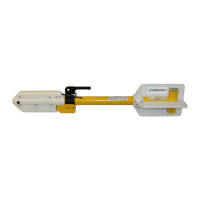Geometrics Inc. G-882 Cesium Marine Magnetometer Page
You will be given the opportunity to save these into a file.
Effects of Depth Calibration
After you have calibrated your depth sensor, you should see immediate
changes in your data. The graphs and displays will use the new calibrated
values.
However, the device file will have the uncalibrated values (.880).
If you need to store calibrated values, you should use the Interpolator device
that will write calculated depths and altitudes in the interpolator file.
Why Should We Calibrate?
This is a brief discussion on how MagLog™ calculates scale and bias values
and why this is needed.
The depth sensor is a pressure transducer. This means that for a given
pressure, it will output a number proportional to the pressure measured.
However, the number is meaningless until we solve for a few factors.
Assume that the depth reading is related to the pressure reading by the
following:
Depth = APressure + b
In this case, the two parameters A and b are the scale and bias values that we
need to find.
We can solve for these two value if we have at least two sets of measurements.
If we measure the following:
Depth MagLog Reading (pressure)
Y1 X1
Y2 X2
I can then get two independent equations:
Y1 = AX1 + b Y2 = AX2 + b
Solving for A and b, I get:
A = (Y1 Y2) (X1 X2) b = (Y2X1 Y1X2) (X1 X2)
From here, we can now use these new values to calculate the correct depth,
given only the pressure.

